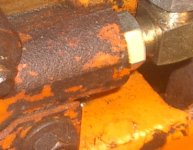I hope so!john_bud said:It sounds like you may have hooked the loader valve up backwards.
I'll be posting pictures in a few minutes. Hopefully you can comfirm that I've gotten it wrongThe relief valve is always (far as I know) on the inlet side. If you hooked it up with the "IN" hose going to the "OUT" of the valve, then when you operate the controls, you are isolating the relief from the fluid. Any over pressure can't be relieved and the weak spot is located with much fan fare and excitement.
john_bud, that is a very interesting thought. I'll be testing the selector valve to see if it blocks incoming flow at any point in its travel. I don't need any more ways to kill my pumpA second thought, your selector valve. If you operate the selector valve while the tractor is running, it may dead head the pump. Instantly killing it. Don't know if that is the case or not here. Just something to beware of.
No, the backhoe is a closed system with its own pump, tank, fluid, etc. ...And it's sitting under a tarp behind the garage.Your hyd diagram does not include the BH circuit. There may be a relationship there, don't know for sure.
That was actually the motivator to this whole catastrophe: I needed to remove the backhoe to install a snow blade on the rear, but didn't have any way to power my loader without it.
No problem there, this is the pump Kubota hung on the side of my motor 30 years ago. And it's pumping the same 80W gear oil that it's been pumping since the beginning, including all winter last year.Also, I got the impression that you put the pump on replacing the function of a PTO pump. Did I read that right? If so, the fluid may be too thick for the pump. Check with the pump mfg to be sure. Over pressure situations can occur even with an operable relief valve if the viscosity is too high. Basically, the fluid can't get out the relief port fast enough to drop the pressure. Again, may not have a bearing on the case. But good to know.
My meddling in this system is the diversion of fluid away from the 3pt hitch lifter (the only use for that pump) and into the FEL.
Thanks very much for your help.
/chris
